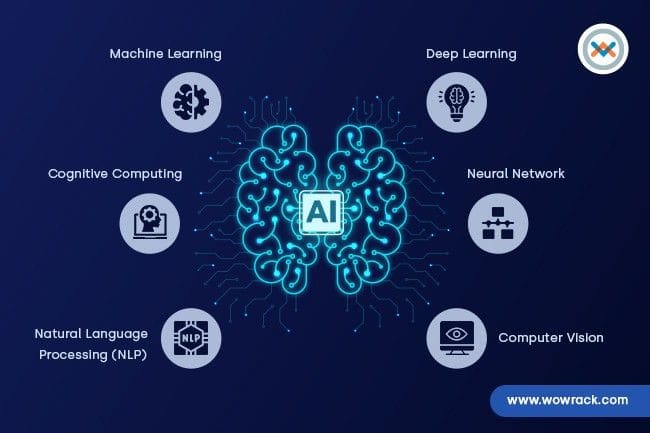AI or Artificial Intelligence has been a trending topic in the tech industry for quite some time now. When we hear the word “AI”, we might think about super smart and complex software such as ChatGPT, Google Assistant, Siri, or Tesla’s Autopilot, but AI goes way beyond just that. In this blog post, we will dive deeper into AI itself — its definition, types, and how it works.
What is AI?
Artificial Intelligence refers to the ability of machines and computers to learn and perform tasks that are usually done by humans. Therefore, Siri, Alexa, smartphones, self-driving cars, chatbots are all products that are powered by AI. Aside from these products, we can also find AI in stuff that we use daily. For example, Facebook can detect and remove content that violates its guidelines even before anyone reports it because it uses AI technology in their content review process, and Waze uses AI to give its users real-time traffic information and suggestions on the fastest route for their destinations.
Components of AI
Cognitive Computing
Cognitive computing is a component of AI that focuses on creating systems that can mimic a human's cognitive abilities, equipping AI to handle tasks that require human-like understanding and reasoning.
Machine Learning (ML)
Machine Learning is what enables computers to learn and make predictions through data analysis. Thus, more data or information it has, the better it becomes.
Neural Networks
Neural networks are a part of Machine Learning. They are called "neural" because they work similarly to the interconnected neurons that our brain uses to process information. Neural networks use interconnected nodes, ore artificial neurons, to process data and recognize the patterns within it.
Deep Learning
Deep learning is a component of machine learning that refers to the use of deep neural networks. Like the structure of human brain, deep neural networks consist of multiple hidden layers that can discover and learn complex patterns and representations from data. Deep learning equips AI systems to be able to handle complex tasks like image or speech recognition.
Natural Language Processing (NLP)
Natural Language Processing is a component of AI that focuses on training computers to understand and generate human language. NLP is what makes chatbots and language translation software possible.
Computer Vision
Computer Vision involves training computers to understand visual data. An example of a technology that utilizes Computer Vision is the facial recognition feature you can find on smartphones.
Types of AI
Narrow AI
Narrow AI, or weak AI, is the most common type of AI. This type of AI is limited to a specific task or a small set of tasks. Therefore, a narrow AI is usually very good at doing a specific task but can’t do any other task aside from that. Most of the AI-powered products that we see today falls under the category of Narrow AI. Take the recommendation system used by Netflix and Spotify as an example, they can help give you recommendations by analyzing your past preferences, but they can’t answer general knowledge questions.
General AI
General AI, or strong AI, is a type of AI that possesses human-like intelligence. They are capable of thinking, learning, and applying what they have learned in solving various problems. This indicates that like us humans, they are capable of handling multiple different tasks. Although this type of AI does not exist yet, researchers and scientists are continuously working on building this strong AI. The head of Google’s DeepMind also recently mentioned that we might be just a few years or a decade away from the arrival of General AI. You can learn more about the latest advancements in AI research by visiting Google DeepMind’s Website here.
Super AI
Just like how the name suggests, Super AI is a type of AI that is super smart, that it surpasses human intelligence. It is still a hypothetical idea, but according to experts, a Super AI will be able to perform tasks better than we do and they will also have their desires and way of thinking that we cannot predict. Although we don't have any real examples of a Super AI yet, we can think of it as the "Skynet" robot in the "Terminator" movie. Skynet demonstrated the ability to make decisions on its own and even gain control over the military systems.
How AI Works
Now that we know what Artificial Intelligence is, we are going to dig into how it works. To put it simply, AI works in 5 steps: Input, Process, Outcome, Adjustment, and Assessment.
Input
In this step, AI collects data or information that will be used for its tasks. The more data an AI system has, the better it can learn and make decisions. It's also important to note that AI cannot gather data on its own; it relies on humans to supply this information.
Let's use Siri as an illustration. When you ask, "Is it going to rain in Seattle today?", your words serve as the input.
Process
AI then uses its algorithms to interpret the data that has been collected. They analyze those data to identify patterns, correlations, and trends within it. Ultimately, the goal of this stage is to analyze and understand the collected data to prepare it for decision-making and/or provide insights in the outcome stage.
Let's use the previous example of Siri again in this stage. After Siri listens to your command or question, using its algorithms, Siri will try to understand your words and what you want.
Outcome
In the outcome stage, AI uses the processed data to generate something out of it. It can come in the form of a prediction, report, recommendation, or automation, depending on what it is designed for. Just like how Siri will show you the weather forecast for today or set an alarm for you after receiving your command and processing it.
Adjustment
AI can also make mistakes, and that is why sometimes the outcome they generate is not always what we want. This leads us to the "adjustment" stage. In this stage, they learn from their past mistakes by analyzing the errors, adjusting their algorithms, and continuing to learn from new data and feedback to improve their performance over time.
For example, if Siri does not get your instructions correctly, you can send your feedback to Apple so they can improve Siri's accuracy and performance.
Assessment
Aside from adjustments, AI also needs to undergo regular assessments to evaluate its overall performance and effectiveness. Its developers will do the assessment process to know which areas need improvement and adjustments. This allows AI to get better over time.
For example, in Apple's latest iOS 17, you no longer must say "Hey Siri", instead you can just say "Siri", which helps you to access Siri more conveniently.
Conclusion
We have learned that Artificial Intelligence is so much more than just ChatGPT or Siri. Those are just examples of products that are powered by Narrow AI. In the future, there will be a smarter, and more advanced AI known as General AI. Perhaps, we might even witness AI that surpasses human intelligence, often referred to as Super AI. Additionally, we've learned about how AI works and how its performance can continually improve over time.
Now that we understand what Artificial Intelligence is and how it works, we are now ready to dive deeper into the applications of AI in the real world. Check out our next blog post where we explore AI’s use cases and ethical considerations, as well as what the future holds for this technology.







